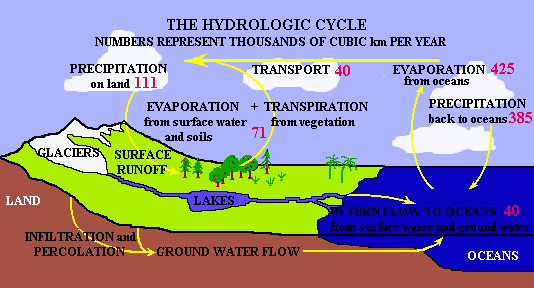|
THE HYDROLOGIC CYCLE
Unique among all the planets in our solar system, the earth has enormous
quantities of liquid water at its surface. At any given instant, the oceans
contain about 97.25% of all the water. A mere 2.05% is locked up in glaciers.
Lakes, rivers, and the atmosphere combined hold less than .02% of the world's
water supply. Ground water accounts for 0.68%. While interesting, these
figures are misleading, because it is not how much or where water is stored
that is critical to shaping landscapes by erosion, but its motion.

Water is in constant cyclic motion, driven by the energy of the sun.
Mostly evaporating from warm tropical oceans, moisture rises and is transported
(generally poleward) by the winds. As it rises, most of it condenses to
clouds, then precipitates, and returns immediately to the oceans. The remainder
moves over land and falls to the ground as rain, snow, sleet, or hail.
In its return trek to the ocean, water can take several routes. Some of
the snow will form glaciers which move downhill and ultimately melt to
mix their water with other surface or ocean water. Streams (rivers) collect
the rain and return much of it to the oceans. Still other water infiltrates
below the surface and seeps downhill as ground water. Most of this returning
water never reaches the sea, for it evaporates from land and transpires
from plants. Evapotranspiration plays an extremely important role. By recycling
rain water, it nearly triples the available water supply on land. Because
they move so slowly, glaciers and ground water contribute little to the
yearly interchange of water when compared to streams; yet over long periods
of time, they also affect landscapes.
| Location |
Volume in Millions of km3 |
Percent |
| Oceans |
1370 |
97.25 |
| Glaciers and ice |
29 |
2.05 |
| Groundwater |
9.5 |
0.68 |
| Lakes |
0.125 |
0.01 |
| Soils |
0.065 |
0.005 |
| Atmosphere |
0.013 |
0.001 |
| Rivers |
0.0017 |
0.0001 |
| Living things (Plants, Animals,.etc.) |
0.0006 |
0.00004 |
| TOTAL |
1408.7 |
|
|


